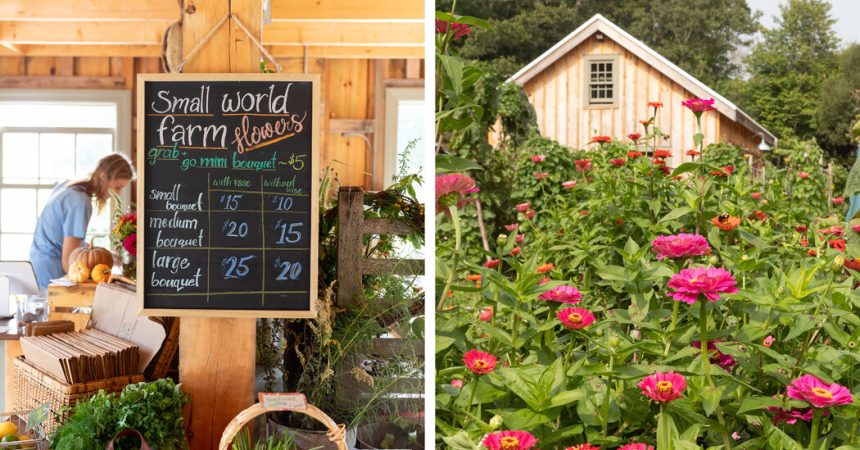“We’re growing a small business and learning as we go,” said Claire Bowen as she arranged bushels of sweet and charmingly imperfect organic apples on a late-September afternoon. “We hope to cultivate connections between local farms and local tables.”
Behind her, rows of brightly hued zinnias and an orchard of 700 apple trees swayed in the fall breeze. Mrs. Bowen, 55, opened Small World Farm and its farm stand with her husband, Patrick, in August and since then their post-and-beam barn has overflowed with autumn’s bounty: bundles of herbs and hand-tied flower bouquets sit next to baskets of apples, squash and peppers. Farther down the winding country roads lies the Young Family Farm’s stand, where cheery orange pumpkins sit alongside buckets of jewel-toned mums, and Sweet & Salty Farm, a dairy and creamery selling cheese and yogurt from cows that graze in pastures tumbling down to the ocean’s edge.

A fishing vessel in Sakonnet Point. Just 30 minutes from Providence, over an hour from Boston and four hours from New York City, the East Bay offers an idyllic fall weekend getaway. Credit…Christine Chitnis for The New York Times
This rural town, with no franchises or traffic lights, is Little Compton, one of several coastal enclaves in the East Bay region of Rhode Island. At this time of year, the sun casts a golden light over rolling farmland and colonial stone walls, with fall leaves painting the landscape in a palette of amber and scarlet. To the west is the striking blue Narragansett Bay, an inlet of the Atlantic Ocean that divides the state.
Beyond the natural grandeur of the East Bay, its charm further stems from a strong sense of community and a reverence for local culinary, artistic and cultural pursuits that are closely tied to the region’s fertile farmland and coastal waters. The results are farm stands galore, a flourishing arts scene and village streets lined with celebrated restaurants.
Just 30 minutes from Providence, over an hour from Boston and four hours from New York City, the East Bay towns of Warren, Bristol, Tiverton and Little Compton offer an idyllic fall weekend getaway.
Autumn in the Ocean State
Rhode Islanders joke that their real summer begins now, that the state’s true beauty unfurls as tourists disperse and the hot weather recedes. With 400 miles of shoreline, the aptly named Ocean State probably packs more beauty within its borders than almost any other coastal destination.
The distance between towns is short — from Warren to Little Compton is roughly 20 miles — and quiet solitude and brilliant seaside views can be found in local nature preserves and public gardens as well as on beaches. Blithewold, a 33-acre oceanfront estate in Bristol, features an English-country-manor-style home and gardens that overlook the bay, while other standouts include Seapowet Marsh, a teeming ecosystem ripe for wildlife spotting; Fogland Beach, a black-stone shoreline perfect for kayaking and windsurfing; and Goosewing Beach Preserve, a sandy barrier strip with grassy dunes. Get the lay of the land by hitting the East Bay Bike Path, a 14.3-mile route that begins in Providence and weaves through Warren and Bristol’s coves, marshes, parks and bridges along the shore of the bay.
While many coastal communities fall prey to overdevelopment, there has been a concerted community effort toward conservation, which has resulted in the preservation of thousands of acres for farming, forestry and outdoor recreation. The Sakonnet Preservation Association, which was founded in 1972 as the state’s first private, nonprofit community land trust, has conserved more than 467 acres, while the Little Compton Agricultural Conservancy has preserved, or been a partner in preserving, more than 2,000 acres. The Tiverton Land Trust has preserved more than 690 acres.
Farm-, orchard- and ocean-to-table
The East Bay once served exclusively as home to the Indigenous Wampanoag tribe. Crops like corn, beans and squash flourished in rich soil, and quahogging (digging for clams) and fishing provided sustenance. Starting in the early 1900s, Portuguese farmers and fishermen settled there, introducing new traditions and flavors. Agriculture and fishing continue to thrive in the region despite challenges — including overfishing, extreme weather events and the rising price of farmland — and have shaped its culinary scene.
It all starts with quality ingredients; sourcing them is half the fun. In Warren, the women-owned Long Lane Farm stretches its growing season into the winter: It can offer an array of greens — spinach, lettuce, bok choy, kale and chard — thanks to high-tunnel growing. Nearby, Sowams Cider Works produces effervescent hard cider from apples grown in its three-and-a-half-acre orchard; with no additives or sulfur, its hard cider depends on native and selected yeasts to ferment and mature.
“I have about 1,000 trees and at least 70 varieties of apples,” said the owner, Spencer Morris, 67. “Each batch of cider is truly an expression of the fruit.” The harvest season begins in mid-August and continues through December. “This business is primarily a farming enterprise,” he said. “I wouldn’t be making cider if I didn’t grow the fruit and have control over the varietals, the way they are grown and the harvest timeline.”
Bristol’s 127-acre Mount Hope Farm hosts year-round Saturday morning farmers’ markets. Make a day of it and explore the farm’s pathways, trails and gardens. In Little Compton, the Wishing Stone Farm celebrated its 40th anniversary this year, and its farm stand teems with produce grown across its 40 acres and in its 15 greenhouses, as well as prepared and preserved foods like soups, salsas and pickles.
Andrade’s Catch, a family-run fish market in Bristol, has sold locally caught seafood since 1987.
“We work with about 50 fishers from across the region,” said Davy Andrade, who has been running the business for the last eight years alongside his father, David. Come autumn, expect to find cases full of black sea bass, crabs, scallops, quahogs and steamer clams, in addition to cod, sole, yellowfin tuna and swordfish.
Hunky Dory in Warren encapsulates the region’s field-to-fork, ocean-to-plate sensibility. Sam Duling, chef and co-owner, regularly visits a roster of farms and purveyors to decide what best captures the seasonal moment.
“Sam is one of the only chefs that comes into the shop to check out our catch instead of just relying on deliveries,” Mr. Andrade said. The result is a menu that emphasizes seasonal produce and protein: Hand-rolled cavatelli served with vegetables and ricotta. Fresh black sea bass grilled and glazed with a preserved-strawberry barbecue sauce. Crispy biscuit fritters served with a spicy honey drizzle.
“I grew up with a Southern mother and grandmother, so my roots are Lowcountry cuisine and Appalachian cooking, the kind of food that relies on what’s in season,” said Mr. Duling, 37. When he arrived in Rhode Island, the abundance of farmers and purveyors made him feel at home. And starting a restaurant in the pandemic — Hunky Dory opened in May 2021 — gave him an even greater appreciation for the community. “In order for restaurants and farms to survive, we need to do it together,” Mr. Duling said.
Artists and makers
The area’s emphasis on keeping things local extends well beyond the culinary realm. Many alumni of the Rhode Island School of Design, in nearby Providence, stay close after graduation, drawn by the natural environment as well as tax incentives. Warren, for one, allows artists who live and work in a specific arts district area to forgo state sales tax and income tax on the sale of artwork, but co-working spaces, workshops, arts nonprofits and galleries are spread around the entire East Bay.
At 30 Cutler, a mill now converted into studio spaces, the RISD graduate Jonathan Glatt houses the showroom, office and factory of his furniture company, O & G Studio. The company designs and manufactures heirloom-quality modern Windsor chairs and other pieces.
For visitors interested in art and shopping, there’s still time to catch the tail end of the Warren Walkabout — a downtown street event held on Oct. 15, 22 and 29 from noon to 5 p.m. Many participating spaces exhibit local work, including the Imago Foundation for the Arts, a gallery this year celebrating its 20th anniversary of championing local art. But on any day of the week, shops on Water and Main Streets sell thoughtfully curated wares, like the vintage jewelry at Muse or metalwork and home goods at Beehive Handmade.
South of Warren, the town center of Tiverton Four Corners also offers delightful art and shopping. Having earned its spot on the National Register of Historic Places in 1974, the two-block stretch is currently full of galleries, antique stores and eateries. Standouts include Four Corners Gallery, the Ashley Ainsworth Art gallery and studio, and Arch Contemporary Ceramics, which serves as a ceramics studio, an artist residency program and a high-end pottery shop.
In 2020, Groundswell joined the Four Corners community by setting up shops, each with their own unique offerings, in three separate historic buildings — a brainchild of David Fierabend, a landscape architect and principal of Groundswell Design Group, as well as a Tiverton resident. In the buildings that now house a cafe, home-goods store and gardening shop, shelves brim with baked goods, kitchenware, gardening décor and terrariums. Outside are gardens adorned with fountains, cafe tables and pollinator plants. Visitors are invited to explore.
“Like most hidden gems, Rhode Island is nuanced, but as you peel back its layers, you are privy to the beauty, the bounty and the community that binds us,” Mr. Fierabend said.
Follow New York Times Travel on Instagram and sign up for our weekly Travel Dispatch newsletter to get expert tips on traveling smarter and inspiration for your next vacation. Dreaming up a future getaway or just armchair traveling? Check out our 52 Places to Go in 2023.










